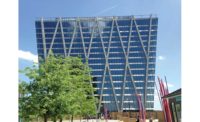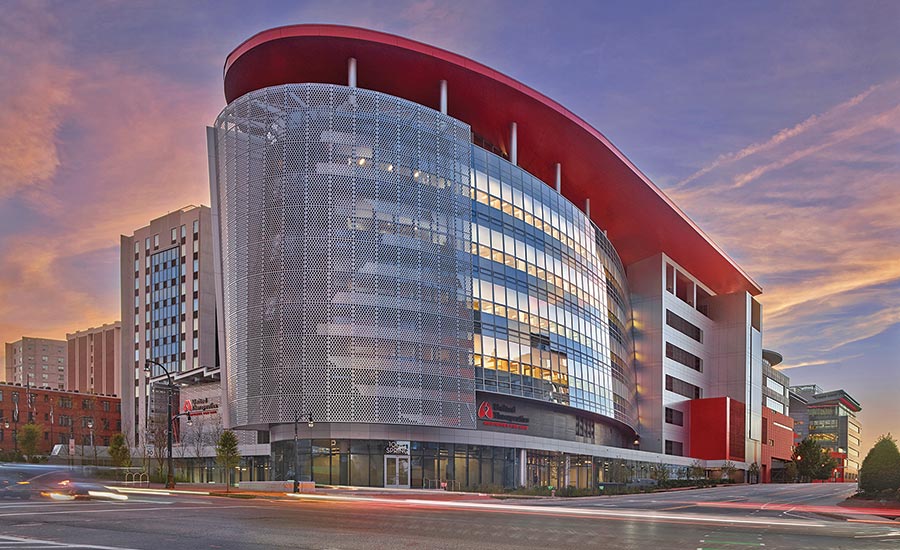ENR MidAtlantic 2019 Best Projects
Best Office/Retail Mixed-Use Developments: Unisphere

The 210,000-sq-ft elliptical Unisphere structure, which achieved LEED Platinum, houses offices and clinical operations as well as a virtual drug development lab and other mixed-use areas.
Photo by Halkin/Mason Photography LLC, courtesy of EwingCole

Unisphere is one of the largest net-zero commercial buildings in the U.S.
Photo by Halkin/Mason Photography LLC, courtesy of EwingCole

To meet net-zero-related requirements, some 15 building systems had to work in unity to achieve such functions as opening windows, tinting glass and optimizing the geo-exchange system.
Photo by Halkin/Mason Photography LLC, courtesy of EwingCole

The project included 75,000 sq ft of structured parking, 10,000 sq ft of retail space and a 5,000-sq-ft atrium.
Photo by Halkin/Mason Photography LLC, courtesy of EwingCole




Unisphere
Silver Spring, Md.
BEST PROJECT
Owner: United Therapeutics Corp.
Lead Design Firm, Structural Engineer & MEP Engineer: EwingCole
Construction Manager: The Whiting-Turner Contracting Co.
Project Management: Stranix Associates
Commissioning Authority: Cornerstone Commissioning
Green Building Consultant: Atelier Ten
Constructing one of the largest net-zero commercial buildings in the U.S. required high levels of coordination while working on a dense urban campus. The need to achieve energy efficiency for the expansion of the owner’s downtown campus was “a challenge that required detailed coordination and innovative thinking,” a judge says.
The 210,000-sq-ft elliptical Unisphere structure, which achieved LEED Platinum, houses offices and clinical operations as well as a virtual drug development lab and other mixed-use areas, including 75,000 sq ft of structured parking, 10,000 sq ft of retail space and a 5,000-sq-ft atrium.
The project was completed two months late due to the facility’s complexity, but it was delivered “significantly under budget,” the team says.
To meet net-zero-related requirements, some 15 building systems had to work in unity to achieve such functions as opening windows, tinting glass and optimizing the geo-exchange system.
“As a quality assurance measure, the team integrated the controls/software portions of these different systems in a lab environment, months in advance of actual implementation,” the team says.
For effective coordination, the team says it used tech tools, including “laser-scanning across multiple applications, robotic total stations for layout of complex geometry and PlanGrid for sharing documentation.”
Fabricating and installing a full-scale mock-up with a complete curtain wall system helped team members visualize the end-product and enabled testing products such as the electrochromic glass. “The mock-up brought together all critical vendors and subcontractors with the design team to ensure that the products chosen matched the intent of the MEP design,” the team says.
From project conception through commissioning, the team held regular meetings that enabled the integration of so many complex systems. The team says it was “immensely helpful to make key design and constructibility decisions while reviewing the full-scale mock-up in person.”
When state law prohibited the team from placing the geothermal wells under the footprint of the building, the owner lobbied for the state legislature to modify the law, the team says. While this was critical for achieving net-zero status, the owner recognized that altering the law would benefit other projects as well.
“The team was also able to overcome challenges associated with the changing tariff and utility landscape,” a Best Projects judge said. During the project’s construction, volatility in the developing photovoltaics market resulted in three of the photovoltaic vendors filing for bankruptcy.
“Through flexibility and teamwork, the project stakeholders successfully navigated each of these events by acting fast and compromising on design changes,” the team says.
Back to "MidAtlantic's 2019 Best Projects Shine Across The Region"





